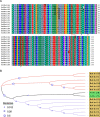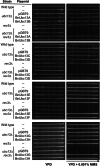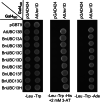Systematic characterization of Brassica napus UBC13 genes involved in DNA-damage response and K63-linked polyubiquitination
- PMID: 36631796
- PMCID: PMC9835285
- DOI: 10.1186/s12870-023-04035-y
Systematic characterization of Brassica napus UBC13 genes involved in DNA-damage response and K63-linked polyubiquitination
Abstract
Background: Ubc13 is the only known ubiquitin conjugating enzyme (Ubc/E2) dedicated to promoting Lys (K)63-linked polyubiquitination, and this process requires a Ubc/E2 variant (UEV). Unlike conventional K48-linked polyubiquitination that targets proteins for degradation, K63-linked polyubiquitination, which is involved in several cellular processes, does not target proteins for degradation but alter their activities.
Results: In this study we report the identification and functional characterization of 12 Brassica napus UBC13 genes. All the cloned UBC13 gene products were able to physically interact with AtUev1D, an Arabidopsis UEV, to form stable complexes that are capable of catalyzing K63-linked polyubiquitination in vitro. Furthermore, BnUBC13 genes functionally complemented the yeast ubc13 null mutant defects in spontaneous mutagenesis and DNA-damage responses, suggesting that BnUBC13s can replace yeast UBC13 in mediating K63-linked polyubiquitination and error-free DNA-damage tolerance.
Conclusion: Collectively, this study provides convincing data to support notions that B. napus Ubc13s promote K63-linked polyubiquitination and are probably required for abiotic stress response. Since plant Ubc13-UEV are also implicated in other developmental and stress responses, this systematic study sets a milestone in exploring roles of K63-linked polyubiquitination in this agriculturally important crop.
Keywords: Abiotic response; Brassica napus; DNA-damage tolerance; K63-linked polyubiquitination; Protein-protein interaction.
© 2023. The Author(s).
Conflict of interest statement
The authors declare that they have no known competing interests.
Figures








Similar articles
-
Drosophila bendless catalyzes K63-linked polyubiquitination and is involved in the response to DNA damage.Mutat Res. 2018 Mar;808:39-47. doi: 10.1016/j.mrfmmm.2018.02.003. Epub 2018 Feb 21. Mutat Res. 2018. PMID: 29518634
-
Zebrafish Mms2 promotes K63-linked polyubiquitination and is involved in p53-mediated DNA-damage response.DNA Repair (Amst). 2012 Feb 1;11(2):157-66. doi: 10.1016/j.dnarep.2011.10.015. Epub 2011 Nov 3. DNA Repair (Amst). 2012. PMID: 22055568
-
Arabidopsis UEV1D promotes Lysine-63-linked polyubiquitination and is involved in DNA damage response.Plant Cell. 2008 Jan;20(1):213-27. doi: 10.1105/tpc.107.051862. Epub 2008 Jan 4. Plant Cell. 2008. PMID: 18178771 Free PMC article.
-
Functions and mechanisms of the Ubc13-UEV complex and lysine 63-linked polyubiquitination in plants.J Exp Bot. 2022 Sep 12;73(16):5372-5387. doi: 10.1093/jxb/erac239. J Exp Bot. 2022. PMID: 35640002 Review.
-
DNA-damage tolerance through PCNA ubiquitination and sumoylation.Biochem J. 2020 Jul 31;477(14):2655-2677. doi: 10.1042/BCJ20190579. Biochem J. 2020. PMID: 32726436 Review.
References
MeSH terms
Substances
Grants and funding
LinkOut - more resources
Full Text Sources
Molecular Biology Databases

